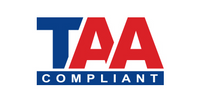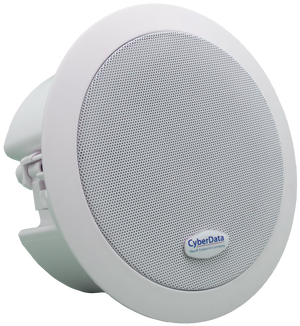011504 InformaCast® Enabled Ceiling Speaker
Part Number: 011504
MSRP: $310.00
- Description
- Features
- Specs
- FAQs
- Installation
- Downloads
The CyberData InformaCast Enabled Ceiling Speaker is an economical Power-over-Ethernet (PoE 802.3af) and Voice-over-IP (VoIP) public address product that plays InformaCast and multicast messages. It easily connects to your PoE network with a single Ethernet cable connection. The device's small footprint allows the speaker to be discreetly mounted in your ceilings.
- Capable of receiving Singlewire InformaCast and multicast messages
- Supports Singlewire InformaCast High Quality Audio
- Supports audio prioritization for 10 multicast paging groups
- Can receive pages directly from Poly phones as well as other devices that can send standard multicast
- Supports delayed pages with buffered multicast
- Network-adjustable speaker volume
- High efficiency speaker driver
- Small footprint
- TLS security for autoprovisioning and web-based configuration
- User upgradeable firmware via web interface or autoprovisioning
- 802.11q VLAN tagging
- Configurable event generation for device health and status monitoring
| Ethernet I/F | 10/100 Mbps | |
| Protocol | RTP | |
| Notification Software | Singlewire InformaCast v4.0 and above | |
| Power Input | PoE 802.3af | |
| Audio Output | 802.3af – SPL 99 dB @ 1 meter | |
| Payload Types | G.711 a-law, G.711 μ-law, G.722 and G.729 | |
| Network Security | TLS/SSL 1.2 | |
| Operating Range | Temperature: -40 degrees C to 55 degrees C (-40 degrees F to 131 degrees F) Humidity: 5-95%, non-condensing |
|
| Storage Temperature | -40 degrees C to 70 degrees C (-40 degrees F to 158 degrees F) | |
| Storage Altitude | Up to 15,000 ft. (4573 m) | |
| Dimensions | 7.93 in. [201.5 mm] Grill Diameter 6.70 in. [170 mm] Can Diameter 3.52 in. [89.4 mm] Can Depth |
|
|
Weight Boxed Weight |
2.4 lbs [1.09 kg] 2.9 lbs [1.32 kg] |
|
| Compliance | CE; EMC Directive – Class A EN 55032 & EN 55024, LV Safety Directive – EN 60950-1, RoHS Compliant, FCC; Part 15 Class A, Industry Canada; ICES-3 Class A, IEEE 802.3 Compliant | |
| Warranty | 5 Years Limited | |
| Part Number | 011504 |
*Dimensions are measured from the perspective of the product being upright with the front of the product facing you.
What is multicast?
IP multicast is a technique for one-to-many communication over a local IP network. IGMP multicast is sent via UDP packets from a multicast server to a multicast receiver. This stream scales to a larger receiver population by not requiring prior knowledge of who or how many receivers there are. Multicast uses network infrastructure efficiently by requiring the source to send a packet only once, even if it needs to be delivered to many receivers. The network replicates the packet in order to reach multiple receivers only when necessary.
Multicast is a great alternative to SIP registration as it does not require that the recipient of the stream to register as an extension on an IP-PBX server.
CyberData products support both regular IGMP multicast as well as proprietary Polycom Group Paging.
How do I update my firmware?
Check to see if your current firmware is the latest version before attempting to update. Download the latest version firmware which includes the Update Firmware Utility. To upload the firmware from your PC, see the Upgrading the Firmware section of the VoIP V2 IP Speaker Operations Guide. See the Downloads tab.
Are your speakers compliant with RFC 3261?
Yes, our speakers are compliant with RFC 3261, but not every SIP extension is fully supported such as extensions for certain phone features that our speakers do not require.
For additional support or answers to questions not covered on this page, who should I contact?
How do I set up a page group in Asterisk?
Page groups are found in the extensions_additional.conf file in Asterisk. The paging group portion of this file should read as follows in which "101 and 102" are the usernames and extensions of two speakers and "103" is the extension used to call the paging group of speakers 101 and 102, and "105" is the extension to call speakers 101,102, and 104:
[ext-paging] include => ext-paging-custom exten => PAGE102,1,GotoIf($[ ${CALLERID(number)} = 102 ]?skipself) exten => PAGE102,n,Dial(SIP/102,5) exten => PAGE102,n(skipself),Noop(Not paging originator) exten => PAGE101,1,GotoIf($[ ${CALLERID(number)} = 101 ]?skipself) exten => PAGE101,n,Dial(SIP/101,5) exten => PAGE101,n(skipself),Noop(Not paging originator) exten => PAGE104,1,GotoIf($[ ${CALLERID(number)} = 104 ]?skipself) exten => PAGE104,n,Dial(SIP/104,5) exten => PAGE104,n(skipself),Noop(Not paging originator) exten => Debug,1,Noop(dialstr is LOCAL/PAGE102@ext-paging&LOCAL/PAGE101@ext-paging) exten => Debug,n,Noop(dialstr is LOCAL/PAGE104@ext-paging&LOCAL/PAGE102@ext-paging&LOCAL/PAGE101@ext-paging) exten => 103,1,Page(LOCAL/PAGE102@ext-paging&LOCAL/PAGE101@ext-paging) exten => 105,1,Page(LOCAL/PAGE104@ext-paging&LOCAL/PAGE102@ext-paging&LOCAL/PAGE101@ext-paging)
; end of [ext-paging]
We would like to communicate directly to your products. Do you have any open source programs you can recommend to do this?
Yes. Try the following links and also contact CyberData support for help Data format: RTP audio 8k G.711 a/u Law 20ms packet time Open source programs:
MAST
https://www.aelius.com/njh/mast/
MAST can handle ulaw and alaw as well as streaming from a mic to a speaker.
Linphone:
https://www.linphone.org/index.php/eng
Linphone has a test application called rtpsend that streams data out as ulaw by default. (It may be trivial to modify this to send in other formats).
What type of files can I send to the IP Speaker in Multicast mode?
| G.711 µ-law or G.711 a-law |
| G.729 |
| 8 bit |
| 8000 hz |
| 160 byte packets every 20ms |
After a period of time, my device stops working or is unreachable.
This is a common problem when the re-registration time value is not set correctly.
On our device, you need to make sure that the re-registration time value (in minutes) is less than that is set on the IP-PBX server.
I see in the electrical connection diagram in the users guide that there is a High PIV Ultra Fast switching diode. Do I need it and if so do you have a source?
This High PIV Ultra Fast switching diode prevents CEMF kick back from an intermediary relay coil when power is cut and the coil field collapses. You could use an On-Semi MUR105 diode.
| Specifications Datasheet | ||
| Digi-Key Part Ordering |
|
The CyberData device connected to a Dell Powerconnect 3524P or 3548P port did not stay linked up. The device comes up, and then it goes down, and then it comes up cycling. If connected to a Linksys SRW208MP switch, the CyberData device stays up.
Pantel, Cisco, or Linksys PoE endpoints all work on the Dell Powerconnect 3524P.
A user tried hard coding the switch speed/duplex and tried four different Dell Powerconnect 3524P switches. --- Check to make sure the Dell Powerconnect 3524P has flow control enabled on the port for the CyberData device to power up properly.
According to Dell: Flow Control Support (IEEE 802.3X): Flow control enables lower speed devices to communicate with higher speed devices by requesting that the higher speed device refrains from sending packets. Transmissions are temporarily halted to prevent buffer overflows. For information on configuring Flow Control for ports or LAGs, see "Defining Port Configuration" or "Defining LAG Parameters" in the Dell© PowerConnect© 35xx Systems User's Guide.
Are there a set of specs. or standards that define proper spacing for your IP Speakers? We need to determine the proper number of speakers for our buildings' corridors. I am looking for something that considers ceiling height and room size/shape to suggest the appropriate quantity. The speaker calculator on your website seems sufficient for square rooms. It is hallways that I am struggling with. The hallways measure 9 feet x 9 feet by 100-150 feet in length.
In a ceiling mount, you would want about 1 per every 10-15 feet of hallway length.
If you used the paging amp you could use 3 paging amps per 100 feet as per this drawing.
This assumes average ambient noise and surface attenuation levels.
The following figure shows the 011061 V2 Paging Amp and the 011068 Horn Loudspeaker:
I am unable to connect with the unit when it is plugged into a Cisco SLM 224P switch.
The cables or switch ports that you are connecting to are set in switch or hub mode instead of endpoint stations. The MDIX setting needs to be changed to MDI since our VoIP products are end stations.
From the Cisco SLM 224P User Guide:
Change to MDI:
MDI / MDIX Â Displays the Media Dependent Interface (MDI) / Media Dependent Interface with Crossover (MDIX) status on the port. Hubs and switches are deliberately wired the opposite of the way end stations are wired, so that when a hub or switch is connected to an end station, a straight through Ethernet cable can be used, and the pairs are matched up properly. When two hubs or switches are connected to each other, or two end stations are connected to each other, a crossover cable is used to ensure that the correct pairs are connected. The possible field values are:
MDIX Â Use for hubs and switches. MDI Â Use for end stations.I have a Cisco 6513 switch. When I plug in a CyberData VoIP device, the device constantly reboots and will not register to the SIP server.
Please adjust the switch power selection to Power inline static, as opposed to Power inline dynamic. This will allow the device to continuously receive 15.4W of power.
I have a Cisco Catalyst series switch. How do I set the unit so that it can use PoE (under 15.4w) instead of an external power source?
There are known PoE limitations with third party devices on the Cisco Catalyst series switches. This includes the 2500, 3500, and 6500 series switches.
Its important to keep in mind that CyberData devices are considered third party devices and require switch port setting adjustments.
Be sure to turn power policing off if it has been enabled on your switch. Power policing is disabled by default. Also, configure your port for no shutdown.
Use the following command to configure inline power: power inline static max 15400
Typical Installation
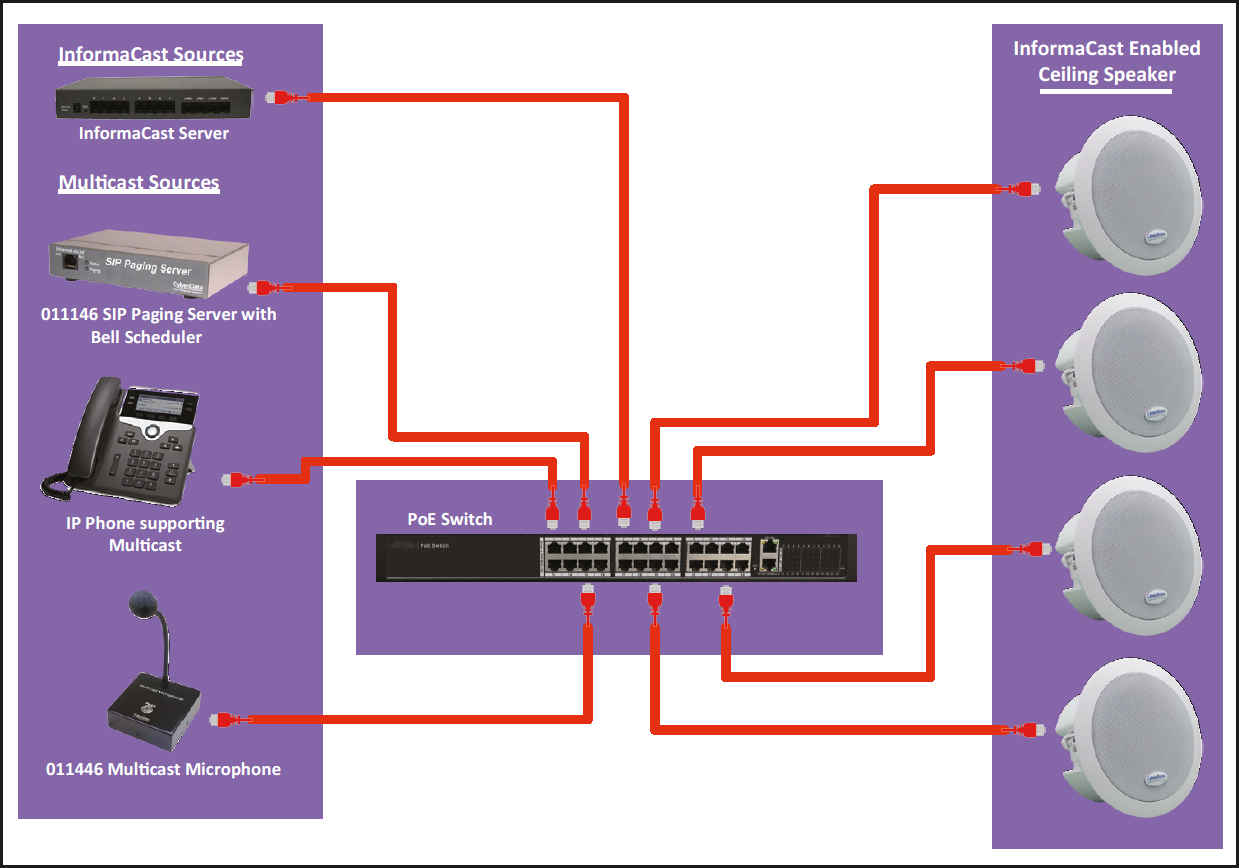
Mounting
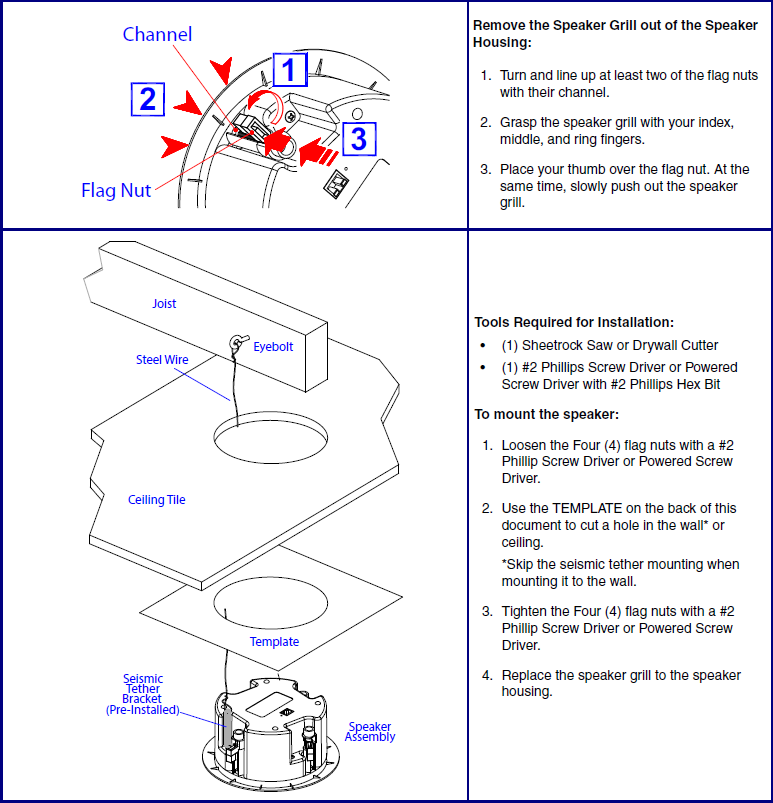
Dimensions
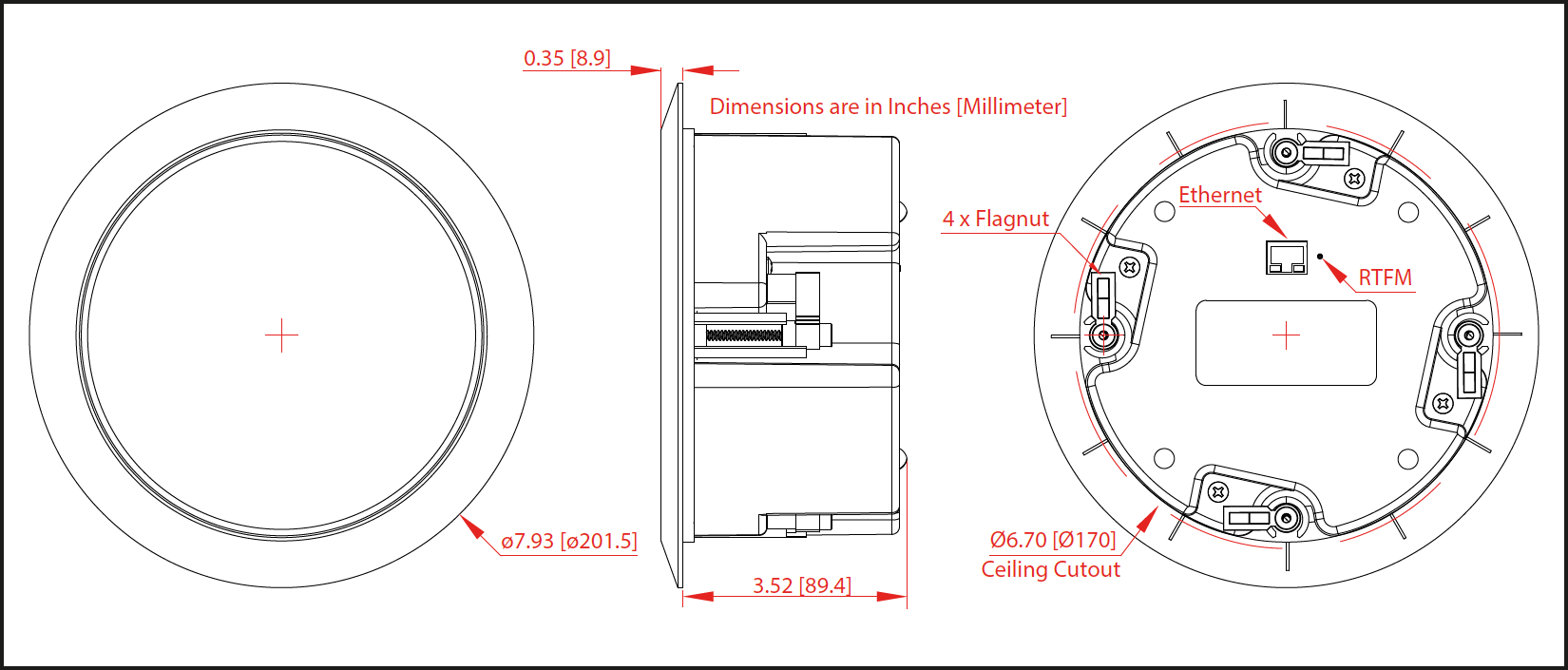
Description
The CyberData InformaCast Enabled Ceiling Speaker is an economical Power-over-Ethernet (PoE 802.3af) and Voice-over-IP (VoIP) public address product that plays InformaCast and multicast messages. It easily connects to your PoE network with a single Ethernet cable connection. The device's small footprint allows the speaker to be discreetly mounted in your ceilings.
Features
- Capable of receiving Singlewire InformaCast and multicast messages
- Supports Singlewire InformaCast High Quality Audio
- Supports audio prioritization for 10 multicast paging groups
- Can receive pages directly from Poly phones as well as other devices that can send standard multicast
- Supports delayed pages with buffered multicast
- Network-adjustable speaker volume
- High efficiency speaker driver
- Small footprint
- TLS security for autoprovisioning and web-based configuration
- User upgradeable firmware via web interface or autoprovisioning
- 802.11q VLAN tagging
- Configurable event generation for device health and status monitoring
Specs
| Ethernet I/F | 10/100 Mbps | |
| Protocol | RTP | |
| Notification Software | Singlewire InformaCast v4.0 and above | |
| Power Input | PoE 802.3af | |
| Audio Output | 802.3af – SPL 99 dB @ 1 meter | |
| Payload Types | G.711 a-law, G.711 μ-law, G.722 and G.729 | |
| Network Security | TLS/SSL 1.2 | |
| Operating Range | Temperature: -40 degrees C to 55 degrees C (-40 degrees F to 131 degrees F) Humidity: 5-95%, non-condensing |
|
| Storage Temperature | -40 degrees C to 70 degrees C (-40 degrees F to 158 degrees F) | |
| Storage Altitude | Up to 15,000 ft. (4573 m) | |
| Dimensions | 7.93 in. [201.5 mm] Grill Diameter 6.70 in. [170 mm] Can Diameter 3.52 in. [89.4 mm] Can Depth |
|
|
Weight Boxed Weight |
2.4 lbs [1.09 kg] 2.9 lbs [1.32 kg] |
|
| Compliance | CE; EMC Directive – Class A EN 55032 & EN 55024, LV Safety Directive – EN 60950-1, RoHS Compliant, FCC; Part 15 Class A, Industry Canada; ICES-3 Class A, IEEE 802.3 Compliant | |
| Warranty | 5 Years Limited | |
| Part Number | 011504 |
*Dimensions are measured from the perspective of the product being upright with the front of the product facing you.
FAQs
What is multicast?
IP multicast is a technique for one-to-many communication over a local IP network. IGMP multicast is sent via UDP packets from a multicast server to a multicast receiver. This stream scales to a larger receiver population by not requiring prior knowledge of who or how many receivers there are. Multicast uses network infrastructure efficiently by requiring the source to send a packet only once, even if it needs to be delivered to many receivers. The network replicates the packet in order to reach multiple receivers only when necessary.
Multicast is a great alternative to SIP registration as it does not require that the recipient of the stream to register as an extension on an IP-PBX server.
CyberData products support both regular IGMP multicast as well as proprietary Polycom Group Paging.
How do I update my firmware?
Check to see if your current firmware is the latest version before attempting to update. Download the latest version firmware which includes the Update Firmware Utility. To upload the firmware from your PC, see the Upgrading the Firmware section of the VoIP V2 IP Speaker Operations Guide. See the Downloads tab.
Are your speakers compliant with RFC 3261?
Yes, our speakers are compliant with RFC 3261, but not every SIP extension is fully supported such as extensions for certain phone features that our speakers do not require.
For additional support or answers to questions not covered on this page, who should I contact?
How do I set up a page group in Asterisk?
Page groups are found in the extensions_additional.conf file in Asterisk. The paging group portion of this file should read as follows in which "101 and 102" are the usernames and extensions of two speakers and "103" is the extension used to call the paging group of speakers 101 and 102, and "105" is the extension to call speakers 101,102, and 104:
[ext-paging] include => ext-paging-custom exten => PAGE102,1,GotoIf($[ ${CALLERID(number)} = 102 ]?skipself) exten => PAGE102,n,Dial(SIP/102,5) exten => PAGE102,n(skipself),Noop(Not paging originator) exten => PAGE101,1,GotoIf($[ ${CALLERID(number)} = 101 ]?skipself) exten => PAGE101,n,Dial(SIP/101,5) exten => PAGE101,n(skipself),Noop(Not paging originator) exten => PAGE104,1,GotoIf($[ ${CALLERID(number)} = 104 ]?skipself) exten => PAGE104,n,Dial(SIP/104,5) exten => PAGE104,n(skipself),Noop(Not paging originator) exten => Debug,1,Noop(dialstr is LOCAL/PAGE102@ext-paging&LOCAL/PAGE101@ext-paging) exten => Debug,n,Noop(dialstr is LOCAL/PAGE104@ext-paging&LOCAL/PAGE102@ext-paging&LOCAL/PAGE101@ext-paging) exten => 103,1,Page(LOCAL/PAGE102@ext-paging&LOCAL/PAGE101@ext-paging) exten => 105,1,Page(LOCAL/PAGE104@ext-paging&LOCAL/PAGE102@ext-paging&LOCAL/PAGE101@ext-paging)
; end of [ext-paging]
We would like to communicate directly to your products. Do you have any open source programs you can recommend to do this?
Yes. Try the following links and also contact CyberData support for help Data format: RTP audio 8k G.711 a/u Law 20ms packet time Open source programs:
MAST
https://www.aelius.com/njh/mast/
MAST can handle ulaw and alaw as well as streaming from a mic to a speaker.
Linphone:
https://www.linphone.org/index.php/eng
Linphone has a test application called rtpsend that streams data out as ulaw by default. (It may be trivial to modify this to send in other formats).
What type of files can I send to the IP Speaker in Multicast mode?
| G.711 µ-law or G.711 a-law |
| G.729 |
| 8 bit |
| 8000 hz |
| 160 byte packets every 20ms |
After a period of time, my device stops working or is unreachable.
This is a common problem when the re-registration time value is not set correctly.
On our device, you need to make sure that the re-registration time value (in minutes) is less than that is set on the IP-PBX server.
I see in the electrical connection diagram in the users guide that there is a High PIV Ultra Fast switching diode. Do I need it and if so do you have a source?
This High PIV Ultra Fast switching diode prevents CEMF kick back from an intermediary relay coil when power is cut and the coil field collapses. You could use an On-Semi MUR105 diode.
| Specifications Datasheet | ||
| Digi-Key Part Ordering |
|
The CyberData device connected to a Dell Powerconnect 3524P or 3548P port did not stay linked up. The device comes up, and then it goes down, and then it comes up cycling. If connected to a Linksys SRW208MP switch, the CyberData device stays up.
Pantel, Cisco, or Linksys PoE endpoints all work on the Dell Powerconnect 3524P.
A user tried hard coding the switch speed/duplex and tried four different Dell Powerconnect 3524P switches. --- Check to make sure the Dell Powerconnect 3524P has flow control enabled on the port for the CyberData device to power up properly.
According to Dell: Flow Control Support (IEEE 802.3X): Flow control enables lower speed devices to communicate with higher speed devices by requesting that the higher speed device refrains from sending packets. Transmissions are temporarily halted to prevent buffer overflows. For information on configuring Flow Control for ports or LAGs, see "Defining Port Configuration" or "Defining LAG Parameters" in the Dell© PowerConnect© 35xx Systems User's Guide.
Are there a set of specs. or standards that define proper spacing for your IP Speakers? We need to determine the proper number of speakers for our buildings' corridors. I am looking for something that considers ceiling height and room size/shape to suggest the appropriate quantity. The speaker calculator on your website seems sufficient for square rooms. It is hallways that I am struggling with. The hallways measure 9 feet x 9 feet by 100-150 feet in length.
In a ceiling mount, you would want about 1 per every 10-15 feet of hallway length.
If you used the paging amp you could use 3 paging amps per 100 feet as per this drawing.
This assumes average ambient noise and surface attenuation levels.
The following figure shows the 011061 V2 Paging Amp and the 011068 Horn Loudspeaker:
I am unable to connect with the unit when it is plugged into a Cisco SLM 224P switch.
The cables or switch ports that you are connecting to are set in switch or hub mode instead of endpoint stations. The MDIX setting needs to be changed to MDI since our VoIP products are end stations.
From the Cisco SLM 224P User Guide:
Change to MDI:
MDI / MDIX Â Displays the Media Dependent Interface (MDI) / Media Dependent Interface with Crossover (MDIX) status on the port. Hubs and switches are deliberately wired the opposite of the way end stations are wired, so that when a hub or switch is connected to an end station, a straight through Ethernet cable can be used, and the pairs are matched up properly. When two hubs or switches are connected to each other, or two end stations are connected to each other, a crossover cable is used to ensure that the correct pairs are connected. The possible field values are:
MDIX Â Use for hubs and switches. MDI Â Use for end stations.I have a Cisco 6513 switch. When I plug in a CyberData VoIP device, the device constantly reboots and will not register to the SIP server.
Please adjust the switch power selection to Power inline static, as opposed to Power inline dynamic. This will allow the device to continuously receive 15.4W of power.
I have a Cisco Catalyst series switch. How do I set the unit so that it can use PoE (under 15.4w) instead of an external power source?
There are known PoE limitations with third party devices on the Cisco Catalyst series switches. This includes the 2500, 3500, and 6500 series switches.
Its important to keep in mind that CyberData devices are considered third party devices and require switch port setting adjustments.
Be sure to turn power policing off if it has been enabled on your switch. Power policing is disabled by default. Also, configure your port for no shutdown.
Use the following command to configure inline power: power inline static max 15400
Installation
Typical Installation

Mounting

Dimensions

Downloads


